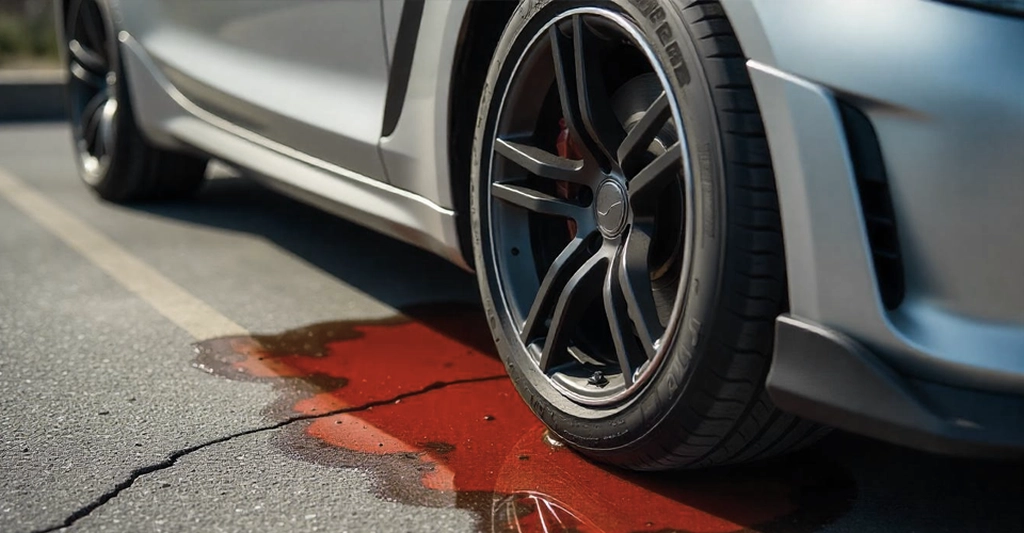Seeing a mysterious puddle under your car can be unsettling. Is it harmless water from the air conditioning or something more serious like an oil or brake fluid leak? The key to figuring it out lies in understanding the type, colour, and smell of the leaking fluid.
In this guide, we’ll walk you through the 10 most common types of car fluid leaks, how to identify them, and what to do next because not all leaks are created equal.
What Should You Do First If Your Car Is Leaking?
Before assuming the worst, take these simple steps:
- Confirm the leak is from your car. If the vehicle was parked in a public spot, that puddle could be from a different car.
- Inspect the leak area. Look underneath to see where the fluid is coming from engine bay, middle, rear, near the wheels?
- Use cardboard to monitor. Place a clean piece of cardboard overnight to observe the leak’s color, consistency, and smell.
- Avoid quick-fix additives. Products labelled as “stop leak” may temporarily seal minor leaks but can damage your engine or hydraulic systems long-term.
Once you identify the fluid, you’ll have a clearer idea of how serious the issue is and whether it’s safe to drive.
10 Reasons Your Car May Be Leaking Fluid
1. Engine Oil (Light Brown to Black)
An engine oil leak is one of the most common problems. Fresh oil is amber or light brown, while older oil turns dark brown or black.
Oil can leak from the oil pan, filter, valve cover gaskets, or crankshaft seals. While a small leak might not seem urgent, running low on oil can lead to severe engine damage. Check your dipstick regularly and top up if needed but don’t ignore the root cause.Tip: Use a torch to inspect for oil trails on the undercarriage. Leaks often travel before they drip.
2. Transmission Fluid (Red to Brown)
Automatic transmission fluid is typically red or pink when fresh, turning brown as it ages. Manual gear oil, by contrast, is thicker and has a strong, sharp smell.
Leaks can stem from axle seals, transmission pan gaskets, or fluid cooler lines. Low transmission fluid leads to gear slippage, delayed shifting, or complete transmission failure.
Tip: If your car revs but doesn’t move properly, check for transmission fluid leaks immediately.
3. Power Steering Fluid (Amber, Red, or Brown)
Power steering fluid can vary in colour depending on the manufacturer Honda uses light amber, while others may use red or clear fluids.
Leaks may come from the power steering rack, pump, or high-pressure hoses. Without enough fluid, the steering becomes noisy and hard to turn, especially at low speeds.
Tip: If you hear a whining sound when turning, check the fluid level and inspect for leaks around the steering components.
4. Brake Fluid (Clear to Yellow or Brown)
Brake fluid starts clear or slightly yellow and darkens with age. It feels oily but has little to no smell.
A brake fluid leak is a serious safety issue. Even a small leak can cause your brake pedal to feel soft or spongy, and in severe cases, it can lead to complete brake failure.
Tip: Never drive a vehicle with a suspected brake fluid leak. Get it inspected immediately.
5. Coolant/Antifreeze (Green, Red, Blue, Yellow, or Orange)
Coolant colours vary by manufacturer, so don’t rely solely on colour. More reliably, coolant has a sweet, syrupy smell due to ethylene glycol, which is toxic.
Leaks often come from worn hoses, the radiator, or the water pump. A low coolant level can cause your engine to overheat, risking a blown head gasket or warped cylinder head.
Tip: Check under the radiator cap only when the engine is cold. Never open it while hot.
6. Water (Clear and Odourless)
Good news: clear, odourless liquid under your car is usually just condensation from the air conditioning system.
Especially common in warm or humid climates, water drips from the AC evaporator drain under the front passenger side. This is completely normal.Tip: If you don’t see water under the car after using the AC heavily, your drain line might be clogged.
7. Fuel (Clear with Strong Petrol Smell)
Petrol leaks are unmistakable the strong smell gives it away, even if you don’t see much liquid.
Leaks can occur from fuel lines, the tank, injectors, or even the fuel rail. Aside from being a fire risk, it can also reduce fuel efficiency drastically and pose health risks from inhalation.
Tip: Never ignore a fuel smell. Turn off the engine and get your vehicle towed for repair.
8. Windshield Washer Fluid (Blue or Clear)
Washer fluid is often bright blue but can also be clear or greenish. It’s watery and may smell like alcohol or chemicals.
Leaks typically occur at the reservoir or the tubing running to the spray nozzles. While not urgent, losing this fluid can become annoying or even dangerous during dusty or rainy weather.
Tip: If your washer jets stop working, check for visible leaks before assuming the pump is faulty.
9. Differential or Gear Oil (Thick, Honey-Coloured, Strong Odor)
Rear-wheel-drive and 4WD vehicles have differentials filled with heavy gear oil. It’s thick, sticky, and has a powerful smell.
Leaks often appear around axle seals, differential housings, or transfer cases. Left unchecked, gear oil leaks can lead to whining noises, vibrations, or differential failure.
Tip: Look for splatter marks on the wheels or undercarriage gear oil spreads as it drips and rotates with the wheels.
10. Hybrid or EV Cooling System Leak (Orange, Pink, or Blue)
Electric vehicles (EVs) and hybrids use special cooling fluids for their battery and power electronics systems. These fluids may look like traditional coolant but are usually color-coded by manufacturer.
Leaks here are less common but just as critical. EV cooling leaks can affect battery performance and lifespan.
Tip: If you notice unfamiliar fluid under your EV, consult a specialist especially for high-voltage components.
Can I Drive with a Fluid Leak?
If the leak is just water from your AC or a bit of washer fluid, you’re likely fine. But if you suspect oil, brake fluid, coolant, fuel, or transmission fluid is leaking, don’t risk it. Continuing to drive could damage your vehicle or even put your safety at risk.
How to Diagnose the Leak at Home
- Use white cardboard or paper under the leak overnight.
- Take a photo and note the location, color, and smell.
- Compare your findings with this guide.
- Top up the fluid only if safe, but never rely on topping up as a solution.
When to See a Mechanic
- If you smell fuel.
- If your brake pedal feels soft or spongy.
- If the steering feels stiff or noisy.
- If your temperature gauge is climbing.
- If the leak gets worse quickly.
Some repairs can be simple like replacing a hose but others (like internal seal leaks) need professional tools and expertise.
Final Thoughts
Car fluid leaks shouldn’t be ignored. While some are minor and harmless, others can lead to major mechanical issues or safety hazards. Being able to identify what’s leaking is the first step toward protecting your carand your wallet.
Need help diagnosing a leak or arranging a professional inspection?
At MotorHub, we connect you with trusted mobile mechanics and workshops across the UAE who can come to your home or workplace. Book a diagnostic visit today and drive worry-free.



